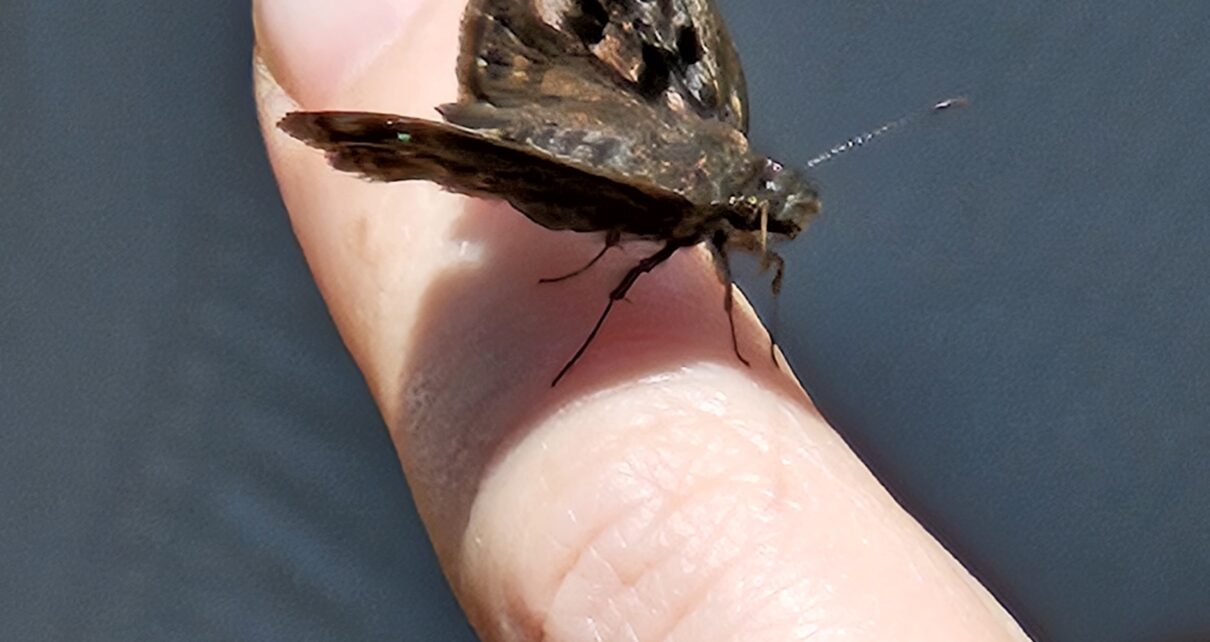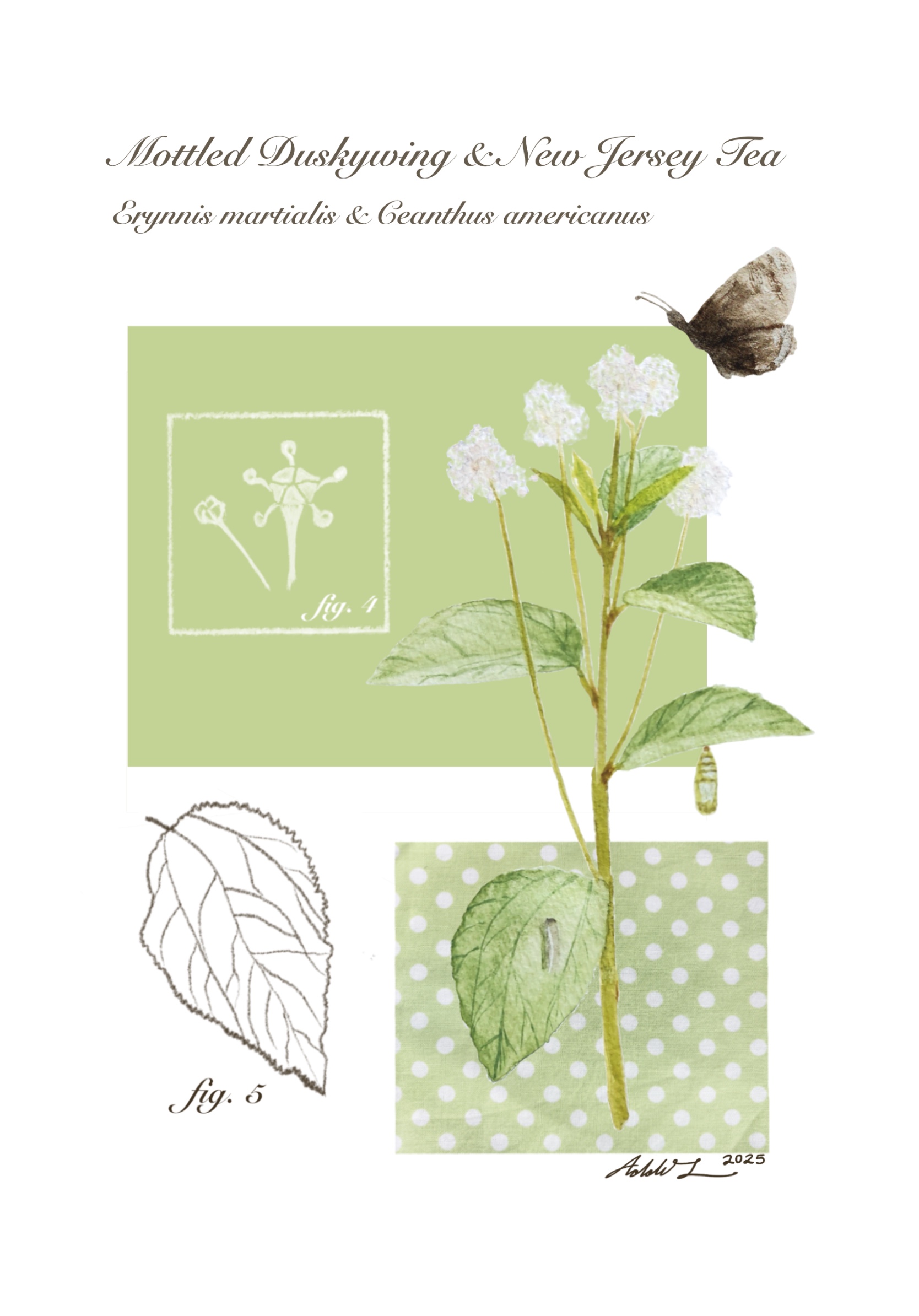The St Williams Conservation Reserve is one of several sites in Norfolk County that will once again play home to the Mottled Duskywing Butterfly (Erynnis martialis). They are in the Skipper family, named for their fast and erratic flight pattern. There are over 3,500 species of butterflies found in the Skipper family. The Mottled Duskywing is a small, dark butterfly that could easily be mistaken for a moth, with a wingspan of between 20 to 30 mm, and is overall dark grey with yellowish-brown spots on its hind wings. The larva of a Mottled Duskywing is green with a dark head.
The Ontario Butterfly Species at Risk Recovery Team (BSAR) has been working on a multi-year plan to reintroduce this butterfly, extirpated in Norfolk County since the late 1980’s. All signs are incredibly positive, with the butterflies reproducing and overwintering successfully.
The Mottled Duskywing Butterfly has only two host plants, Prairie Redroot (Ceanothus americanus) and New Jersey Tea (Ceanothus herbaceous); the two are closely related.
In Norfolk County, the Duskywing goes through metamorphosis only on the New Jersey Tea plant. It lays its eggs there and once hatched, the larvae (think caterpillar!) build leaf nests with silk, and then they either pupate almost immediately (spin a chrysalis and emerge as an adult), or the larvae will overwinter at the base of the plant, emerging in the spring as adults.
Larvae pupate between mid-May and late June. The adult butterfly then consumes nectar from the New Jersey Tea plant. It is truly a closed circuit!
Before the butterflies could be reintroduced to their native oak savannah habitat, the host plants needed to be well established in the area. The St Williams Conservation Reserve has worked to rehabilitate suitable sites for New Jersey Tea to encourage a healthy, thriving population. Since the plant is the only one used by the Mottled Duskywing Butterfly, it had to be present in sufficient quantities to support the reintroduced population.
New Jersey Tea is a compact shrub with glossy green leaves and small white flowers. It is drought tolerant, with a deep tap root, and benefits from carefully controlled prescribed burns conducted in the SWCR – these burns remove invasive species that can crowd the New Jersey Tea plants from establishing. It prefers full sun and a dry location, a perfect fit for oak savannas.
Oak savannah habitat is rare in Ontario and the SWCR has several such areas that have been undisturbed by human activity.
A documentary, “Butterflies on the Brink: The Story of the Mottled Duskywing” was created in 2024, following the Cambridge Butterfly Conservancy, where thousands of Duskywings were raised in preparation for the project, teams working to locate suitable sites for release, monitoring of the butterflies after release, and the all-important spring survey to locate Duskywings that had overwintered. This is a team effort, involving multiple agencies at several locations and often trial and error processes.
Another piece of the puzzle was the development of a captive rearing protocol for this butterfly. That’s where Cambridge Butterfly Conservatory came in and they have developed and fine-tuned a successful process since its inception in 2019.
Jessica Linton, Senior Biologist with Natural Resource Solutions Inc (NRSI) has been overseeing the project since its inception and she is passionate about it. Where you find butterflies, you’ll find Jessica. She has been involved in several reintroductions and shows no sign of slowing down her crusade to support habitat restoration so native butterflies and other native wildlife can once again thrive where they have in the past. It is part science part passion project. And the butterflies benefit endlessly!
With reintroduction programs like this, fragmentation is a problem. Restoring habitat within prescribed areas such as the St Williams Conservation Reserve is crucial but it is important to encourage the public to grow New Jersey Tea on their property as well. It is impossible to contain wildlife within arbitrary boundaries set by property ownership. Butterflies will wander. Having pockets of New Jersey Tea will encourage the butterflies to reestablish across their former range.
The cliche “it takes a village to raise a child’ certainly applies here – just some of the organizations involved in the Ontario Butterfly Species at Risk Recovery Team include Cambridge Butterfly Conservatory, the Norris Lab of the University of Guelph, Nature Conservancy Canada, Wildlife Preservation Canada, Canadian Wildlife Service, Natural Resource Solutions Inc. and many more.
If you are interested in volunteering, or learning more about endangered butterflies, please visit the Ontario Butterfly Species at Risk Recovery Team website at https://www.onbutterflysar.com/.
An exciting point to mention: in 2025 there have been Mottled Duskywing Butterflies spotted in the St Williams Conservation Area, having overwintered on the now well-established New Jersey Tea plants. This is the kind of success story we need more of in the world!




